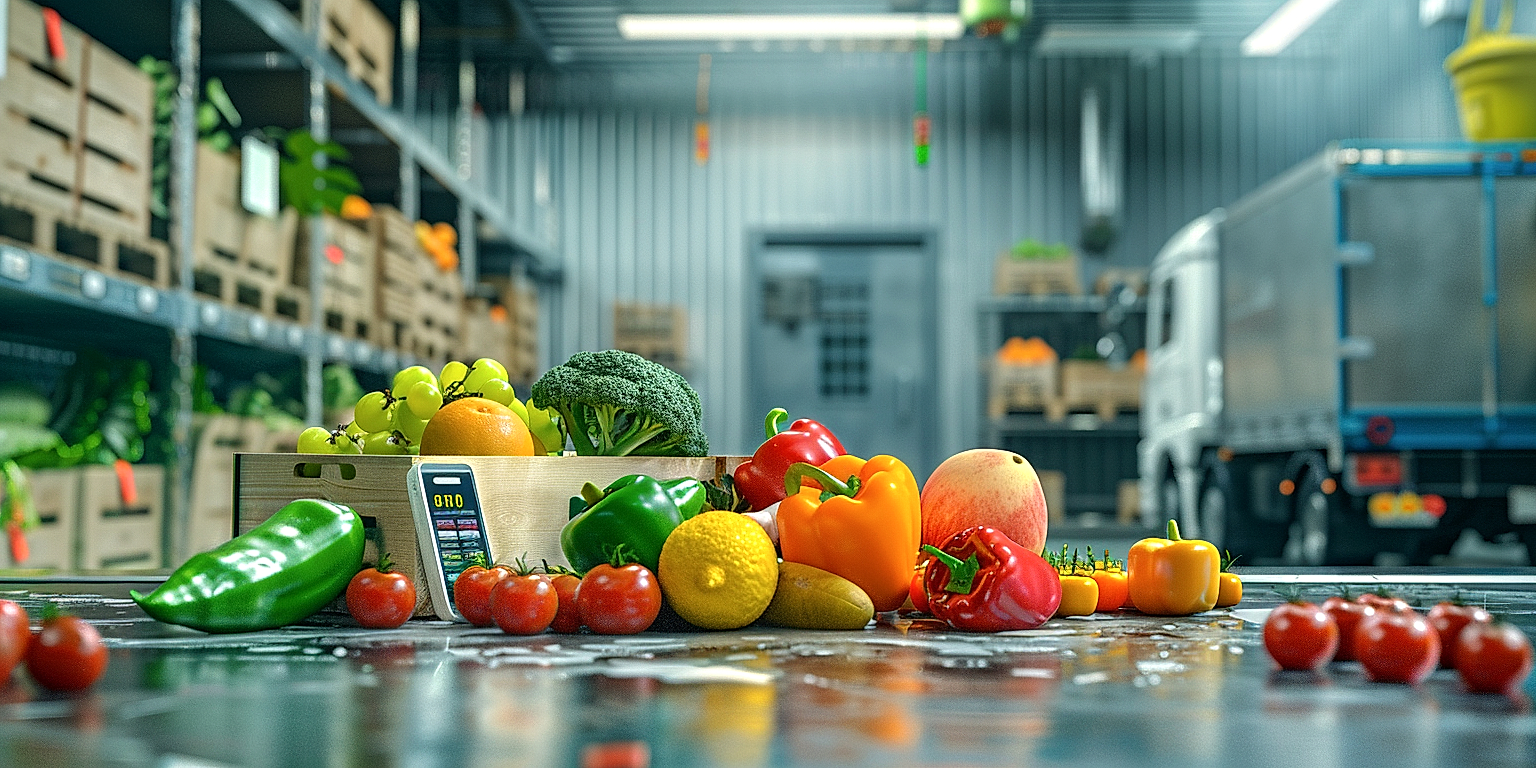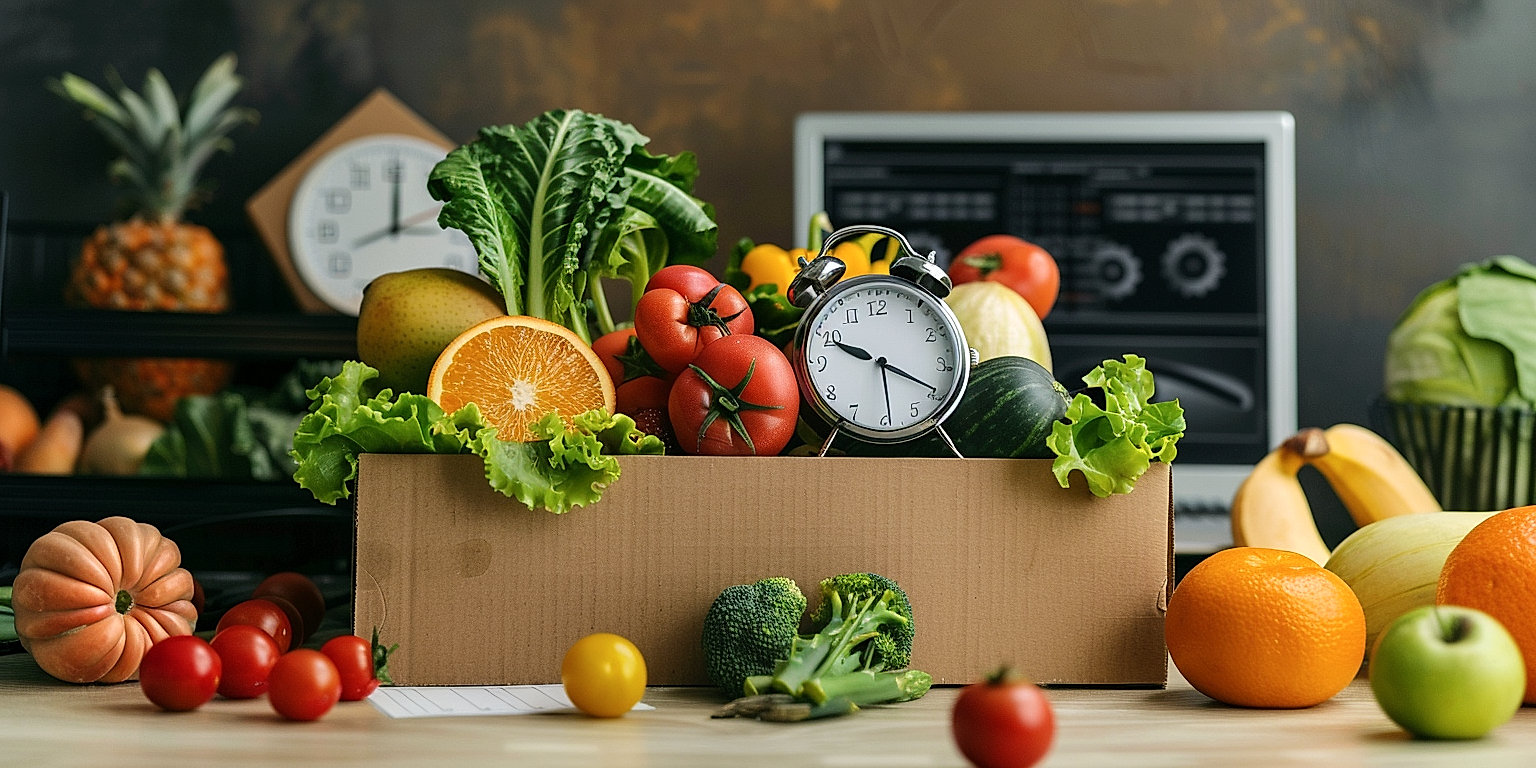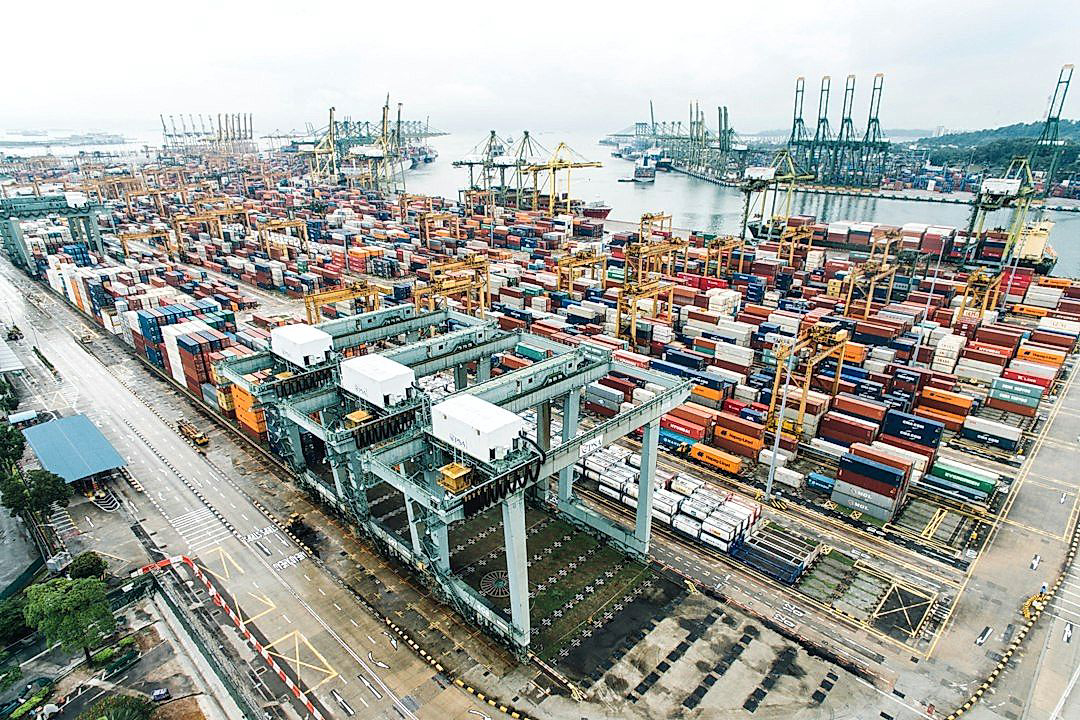In the world of agriculture, the handling and transportation of produce is an integral part of the supply chain.
Each step, from harvesting to shipping, plays a pivotal role in maintaining the quality of the goods.
Mistakes at any juncture can be costly, resulting in waste, reduced profits and even potential health risks.
This is why adopting efficient techniques in this process is crucial.
In the following sections, we will delve into some of these techniques.
By implementing them, operators in this field can optimize their workflows, ensuring freshness and quality while minimizing losses.
Contents
- Techniques For Efficient Produce Handling & Shipping
- 1. Maintain optimal product temperature for freshness.
- 2. Use Proper Packaging and Palletizing Techniques
- 3. Implement a first-in, first-out inventory system.
- 4. Schedule Regular Equipment Maintenance Checks
- 5. Use computerized tracking for inventory management.
- 6. Efficiently Plan and Route Transportation.
- 7. Always adhere to health and safety guidelines.
- 8. Train Employees on Proper Handling Procedures
- 9. Regularly Clean and Disinfect Storage Areas
- 10. Manage and reduce produce handling time
- The Bottom Line
Techniques For Efficient Produce Handling & Shipping
1. Maintain optimal product temperature for freshness.
The quality and freshness of produce is directly dependent on the temperature at which it is maintained during storage and shipping.
This concept of temperature regulation is paramount in the produce industry, as it contributes significantly to the overall product quality and shelf-life.
Produce, such as fruits and vegetables, have different optimal storage temperatures that ensure their freshness over time.
For instance, apples are best stored at temperatures between 30-32°F, while tomatoes require a much warmer climate ranging from 55-60°F to retain their freshness.
Understanding these optimal temperature ranges for different types of produce is the first step towards maintaining their freshness during handling and shipping.
One of the most common methods of maintaining optimal temperature is the use of refrigerated storage and transportation units.
These units are designed to maintain a constant temperature that ensures the freshness of the produce throughout the handling and shipping process.
However, simply having a refrigerated unit is not enough; it should also be properly calibrated and monitored regularly to ensure consistency in temperature.
This can be done using thermal sensors or manually checking the internal temperature of the unit at regular intervals.
Apart from storing the produce at proper temperatures, it is also essential to maintain the temperature during the transit.
Changes in temperature during transit can lead to ‘chilling injury’ in some fruits and vegetables, which can negatively affect their quality and freshness.
To avoid this, the transition between storage and transportation should be as smooth as possible, with the produce being exposed to fluctuating temperatures for the shortest time possible.
Additionally, it is important to remember that the packing material used can also significantly affect the temperature regulation of the produce.
Materials that have poor insulation properties can lead to a quicker increase in temperature, thereby shortening the lifespan of the produce.
Thus, in addition to adequate refrigeration, selection of appropriate packing material is equally essential for optimal temperature regulation.
Lastly, it is worth noting that the temperature regulation is not a standalone process but rather a part of the bigger produce handling and shipping process, which should all work in tandem to ensure the freshness and quality of the produce.
2. Use Proper Packaging and Palletizing Techniques
The importance of using proper packaging and palletizing techniques in the handling and shipping of produce cannot be overstated.
Proper packaging is crucial in preventing damage to produce during transit, helping to maintain product freshness and quality.
Different types of produce require different types of packaging materials and methods, such as corrugated boxes, vented bags, clamshells, or crates, with each type offering varying degrees of protection for the produce.
Optimum packaging also allows for efficient distribution and logistics, making it easier to move and stack products in storage areas and during transport.
Palletizing, on the other hand, refers to the process of stacking and securing goods on a pallet for transportation or storage.
Proper palletizing is necessary to minimize product damage, optimize space utilization, and ensure convenient retrieval and handling of boxes or bags.
When palletizing, it is crucial to evenly distribute weight, alternating and aligning boxes to increase stability and reduce the risk of overhanging, which could lead to product damage.
Pallet pattern and stack height are also important factors to consider, with the aim being to maximize the number of boxes/bags on a pallet without compromising product safety and quality.
Use palletizing software can be an excellent way to optimize the palletizing process, ensuring that goods are stacked in the most space-efficient and secure way possible.
Inappropriate packaging and poorly executed palletizing can lead to unnecessary product losses and increased shipping costs, making them critical aspects of efficient produce handling and shipping.
Packaging and palletizing solutions should thus be selected based on a number of factors, including the nature of the produce, the intended mode of transport, and the forecasted storage conditions.
The use of automated packaging and palletizing systems can further improve efficiency, reduce labor costs, and ensure consistent quality in the handling and shipping of produce.
Investing in proper packaging and palletizing techniques ultimately results in higher product integrity, lower shipment costs, and increased customer satisfaction in the long run.
The packaging and palletizing process also needs to be regularly evaluated to ensure that it remains effective and adapts to any changes in product variety or shipping requirements.
While proper packaging and palletizing techniques necessitate initial investment and training, the financial returns in the form of reduced product losses and improved logistical efficiencies make them an essential aspect of effective produce handling and shipping.
3. Implement a first-in, first-out inventory system.
One critical component in the successful handling and shipping of produce involves employing an inventory system that ensures freshness and optimal consumer satisfaction.
The First-In, First-Out (FIFO) inventory management system is a highly recommended method for this type of industry.
With the FIFO system, the oldest products are sold first, assuring that no item is unnecessarily wasted or spoils because of extended storage time.
The FIFO system is consistent with the physiological fact that the longer the produce stays stored, the more likely it is to lose its freshness, nutritional value, taste, and visual appeal.
This inventory system not only minimizes waste and inventory costs, but also creates a consistent flow of the produce from the point of production to the point of sale.
One of the fundamental stages in deploying a FIFO inventory system involves clearly labelling each batch of produce with its production or delivery date.
Labels facilitate quick and easy identification of the stock to be moved first and encourages a systematic operation.
An efficient FIFO system calls for a well-organized storage facility where new stock can be added without disturbing the order of the old stock.
A well ordered and segmented storage facility simplifies the process of stock rotation, enhancing efficiency and effectiveness in produce handling and shipping.
Where physical segregation and arrangement of products may not be feasible, adopting a computerized FIFO system can provide an effective alternative.
Such a system automatically keeps track of the inventory, ensuring accurate information on the age of the stock and aiding the elimination of errors in product rotation.
Another advantage offered by FIFO system includes aiding businesses in managing their financials effectively.
This is possible as the cost of inventory sold will reflect the cost of the earliest purchases, making it responsive and accurate in inflationary scenarios.
FIFO system takes into consideration the product life cycle and perishable nature of the produce, ensuring they reach consumers when still fresh and prime for consumption.
Overall, the FIFO system, when implemented properly, ensures efficiency, reduces waste, maintains product quality, and enhances customer satisfaction in the realm of produce handling and shipping.
4. Schedule Regular Equipment Maintenance Checks
Properly maintaining your equipment is an integral part of any successful produce handling and shipping operation.
As such, it’s important to regularly schedule equipment maintenance checks to ensure that all your devices are running optimally.
The efficiency of your operation can be significantly reduced if equipment is not performing at its best, leading to a slower processing speed and a potentially negatively impacted cooldown time.
This is especially critical for cold storage and refrigeration units, which need to maintain optimal temperatures to keep produce fresh during handling and shipping.
Periodic maintenance checks can help identify any existing issues before they become major problems, thus preventing expensive repairs and operational downtimes.
Maintenance checks should be carried out systematically, with trained professionals examining each part of your equipment for potential faults.
The frequency of these checks generally depends on the type of equipment and how intensively it’s used, but as a rule of thumb, more frequent checks result in less unscheduled downtime.
On top of this, cleaning should be an integral part of your equipment maintenance.
Produce residues and dust can build up on your equipment over time, potentially causing malfunctions and impacting the quality of your produce.
Regular cleaning can help prevent these issues and improve the longevity and performance of your equipment.
Besides, a properly documented equipment maintenance schedule can also help improve the efficiency of your maintenance team by planning in advance for downtime and spare parts procurement.
Ultimately, scheduling regular equipment maintenance checks is a preventative measure that can save you time, money, and potential headaches in the long run.
In a nutshell, a systematic approach to equipment maintenance can make a significant difference in the efficiency and profitability of your produce handling and shipping operation.
Maintaining your equipment will not only ensure that it runs smoothly but also extends its lifespan and helps you avoid unnecessary costs and delays.
With a proactive approach, potential problems can be detected early and rectified before they escalate, thereby ensuring your operation remains productive and your produce remains fresh and safe during transit.
5. Use computerized tracking for inventory management.
Utilizing computerized tracking for inventory management is essential in the maximization of efficiency in produce handling and shipping.
This involves the use of specific software or applications designed to monitor inventory levels, sales, orders, and deliveries.
With the implementation of such systems, companies are capable of keeping accurate records and avoiding mistakes associated with manual bookkeeping.
Computerized tracking systems provide precise, immediate, and updated data about the inventory, ensuring efficient management and quick decision-making.
The application of these systems optimizes productivity and accuracy, leading to improved business operations.
The use of computerized systems also allows for real time inventory management.
This is the ability to track inventory levels in real-time, providing instant access to data about what’s in stock and what needs replenishing.
Through this approach, businesses can prevent stockouts and overstocking, ensuring that the right amount of produce is always available to meet the demand.
In addition, computerized tracking systems can offer insights into trends in sales and customer behavior.
Businesses can take advantage of these trends to enhance their planning, forecasting, and supply chain management.
Computerized inventory tracking also enables integration with other systems, such as accounting and customer relationship management (CRM) systems.
This contributes to a centralized and coordinated approach to business operations ensuring all departments are working from the same data.
Another essential feature of computerized inventory tracking systems is the ability to provide detailed reports and analysis.
These reports can help businesses make more informed decisions, increasing overall business efficiency, and even informing future business strategies.
Thus, implementing a computerized tracking system for inventory management can significantly streamline the control and delivery of fresh produce, contributing to the overall efficiency of the business.
In essence, the use of computerized tracking systems is an integral part of modern, efficient produce handling and shipping strategies.
6. Efficiently Plan and Route Transportation.
Effective planning and routing in the transportation of produce is crucial as it directly affects the quality of the produce upon arrival.
With the advancement in technology, the use of sophisticated routing software has become a standard practice in the industry.
This software helps in determining the most optimal routes that save time and resources.
It’s important to plan the routes effectively to minimize travel time and thus maintain the freshness of the produce.
Labor cost and fuel consumption can be significantly reduced by effectively planning the transportation route in advance.
Ensuring quick delivery should be a priority as it can drastically decrease the chances of the produce spoiling or getting damaged.
Furthermore, regular review and improvement of these routes can lead to even better efficiency and savings.
It’s also important to consider other factors like weather conditions, road conditions, and rush hours while planning the routes.
Produce should be transported during off-peak hours to avoid heavy traffic and delays.
Apart from these, the preference should be given to routes that are well-maintained for a smooth journey which reduces the chance of damage to the produce.
On-time delivery ensures the freshness of the produce which ultimately leads to customer satisfaction and repeat business.
Remember that the planning and routing of transportation should be flexible enough to accommodate unexpected changes.
Transport vehicles should be equipped with temperature control systems which can maintain the desired temperature throughout the journey.
In case of long-distance transportation, make sure to plan for appropriate rest stops to check the condition of the produce.
Lastly, it’s not just the quickest route that needs to be considered but also the safest and most cost-effective.
7. Always adhere to health and safety guidelines.
The implementation of health and safety guidelines is an indispensable component in the handling and shipping of produce.
Strict adherence to the set regulations and operational codes help in the prevention of foodborne diseases that may arise from contamination.
Every employee involved in the handling and shipping process must be well versed in sanitary and safety protocols to maintain a high standard of hygiene.
Regular training sessions on food safety should be made mandatory for staff to increase their competency in managing produce.
Using protective clothing such as gloves, face masks, and hairnets is crucial in minimising the risk of contamination.
Proper handwashing facilities and sanitizers should be installed at strategic points within the establishment to encourage regular cleanliness.
Also, critical is the use of approved cleaning agents that are powerful enough to kill bacteria and other pathogens without compromising the produce’s safety and quality.
All waste should be managed correctly and disposed of promptly to limit attraction of pests and the likelihood of produce contamination.
Regular inspections by health officers can also ensure adherence to guidelines and identify areas that need improvement.
It’s essential also that produce handlers get immunizations against diseases such as Hepatitis A and Typhoid that can be transmitted through food to protect consumers.
All equipment used in handling and shipping, such as forklifts and pallets, must be regularly cleaned and sanitized to prevent cross-contamination.
Lastly, there should be a well-crafted emergency response protocol in case of any accidents or incidents of food contamination.
Implementing these health and safety regulations will not only help in creating a safe working environment for the handlers but also maintain the integrity of the produce being delivered.
The adoption of these health and safety guidelines therefore effectively becomes a critical aspect of efficient produce handling and shipping.
With the stringent application of these guidelines, businesses can prevent produce contamination, guaranteeing consumers receive fresh and healthy products while maintaining the company’s reputation in the highly competitive produce industry.
8. Train Employees on Proper Handling Procedures
The efficiency of produce handling and shipping is heavily influenced by the skill and knowledge of the employees operating the systems and procedures.
In order to maintain the quality of products and ensure safe and hygienic operations, it is crucial to train employees on proper handling procedures.
Training should be a continuous process, starting from the moment an employee is hired, with ongoing refreshers to keep all staff up-to-date with the best practices and any changes in regulations.
Employees need to understand the importance of their roles in the entire process, from sourcing to shipping, and how their actions affect the quality of the produce and the reputation of the business.
Training should include both theoretical lessons and practical demonstrations to ensure understanding and practice of correct handling procedures.
For example, employees should be trained on the importance of maintaining optimal product temperature, and how to do this through the various stages of handling and shipping.
They should understand the importance of proper packaging and palletizing techniques, and how incorrect methods can lead to product damage and wastage.
Trainings should reinforce the importance of a first-in, first-out inventory management system, and how to properly implement and maintain it.
Furthermore, employees should be trained on how to operate the equipment they will be using in their daily tasks and how to address any minor maintenance issues that may arise.
The importance of regular cleaning and disinfection of storage areas should also be included in the training sessions to ensure that everyone knows how to maintain a hygienic work environment.
Including computerized tracking in the training schedule will ensure everyone is comfortable with technology and can efficiently manage inventory.
By incorporating health and safety guidelines into the training plan, businesses can ensure that all staff members have the knowledge they need to work safely and effectively.
Training programs for proper produce handling and efficient shipping may involve external courses, in-house training sessions or a combination of both, depending on the specific needs and circumstances of the business.
Properly training employees not only increases efficiency, it also boosts morale and creates a positive work environment where everyone understands their roles and responsibilities.
In summary, employee training is a critical component in maintaining efficient produce handling and shipping systems.
9. Regularly Clean and Disinfect Storage Areas
Keeping storage areas clean and disinfected is a high priority when handling and shipping produce.
Critical to maintaining product quality and preventing contamination is the regular cleaning and disinfection of these areas.
Periodic sanitation ensures the optimal storage of products and reduces the chances of posing health risks to consumers.
A clean storage environment helps minimize the amount of harmful bacteria, fungi, and pests which can damage the produce and cause significant financial loss.
Regular cleaning also ensures compliance with health and safety regulations, which is crucial for all produce-handling firms to maintain their licenses and avoid getting penalized.
Disinfection, in particular, is not just about removing visible dirt or debris but about eliminating microorganisms capable of causing diseases or spoiling produce.
Use of approved disinfectants should be according to manufacturer instructions to get maximum effectiveness.
Furthermore, regular audits for cleanliness should be undertaken to ensure compliance with established guidelines.
Special attention should be given to areas often overlooked, such as corners, floors, walls, ceilings, and hard-to-reach spots.
Proper garbage disposal and recycling processes also play a significant part in maintaining a clean and healthful storage area for produce.
It is also critical that cleaning schedules cater to the specific needs of the produce being handled, as different fruits and vegetables have different needs and vulnerabilities.
Companies also need to have a system in place for cleaning and disinfecting the tools and equipment used in handling and transporting the produce.
In addition to this, it’s also vital to have a well-trained cleaning staff who are aware of the correct cleaning procedures, the potential hazards, and the importance of their role in maintaining quality produce.
A team that understands the value of a clean storage environment will be able to consistently deliver fresh and high-quality produce to customers.
Through ensuring that the environment from which the product is stored and shipped is clean and disinfected, companies can promote customer satisfaction and safety while minimizing product loss and maximizing profits.
In conclusion, the careful and regular cleaning of storage areas is an indispensable technique in efficient produce handling and shipping.
10. Manage and reduce produce handling time
One of the most crucial aspects of ensuring the efficiency of produce handling and shipping is to effectively manage and reduce the time it takes to handle the produce.
Part of this involves strategically planning the routes for collection and delivery to minimize unnecessary waiting times.
Long handling times can lead to product spoilage, decline in freshness, and consequently, loss of product value and customer satisfaction.
Efficient management of produce handling involves using automated systems where possible to speed up the process.
Gadgets like conveyor belts, automated sorting and packaging machines can help to significantly reduce handling time.
Deploying trained personnel proficient in handling various types of produce promptly and safely is also a valuable technique to manage and reduce handling time.
Aside from the proper usage of equipment, the organization and layout of storage and processing areas should be designed for optimizing workflow.
A well-thought-out layout can significantly reduce unnecessary movements, contributing to more efficient handling and shipping processes.
Another effective approach to managing and reducing handling times is through continuous monitoring and analysis of the process performance.
Time studies can identify bottlenecks and inefficiencies that can be improved upon.
Lastly, reducing the handling time is also about minimizing physical handling of produce wherever possible.
The use of bulk containers and pallets can lessen individual handling of produce items and thus quicken the process.
Equipping the workforce with proper tools and equipment will also lower the handling time and hence increase productivity.
Implementing innovative technologies such as radio frequency identification (RFID) can help track and manage produce efficiently, which will further speed up the process.
Remember, shorter handling times mean less chance for damage or contamination, making it a cornerstone for efficient produce handling and shipping.
Overall, great success in the management and reduction of produce handling time can be achieved through regular analysis, continuous improvement, and utilization of suitable technology and handling techniques.
The Bottom Line
Optimal management of perishable items, such as farm produce, requires a blend of various multidimensional strategies.
These involve maintaining the appropriate product temperature to ensure freshness, effective packaging and palletizing, as well as a good inventory system.
Additionally, routine inspection and maintenance of equipment, along with modern technology for inventory tracking, contribute significantly to efficiency.
Practical and timely transportation planning, compliance with health and safety regulations, and proper staff training on product handling are key.
It’s also crucial to keep storage areas clean while minimizing the handling time for produce.
All these strategies combined lead to optimal produce preservation, enhancing overall business productivity and profitability.




